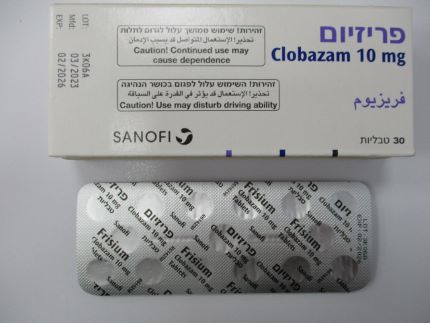Quest for the right Drug

פריזיום FRISIUM (CLOBAZAM)
תרופה במרשם
תרופה בסל
נרקוטיקה
ציטוטוקסיקה
צורת מתן:
פומי : PER OS
צורת מינון:
טבליה : TABLETS
עלון לרופא
מינוניםPosology התוויות
Indications תופעות לוואי
Adverse reactions התוויות נגד
Contraindications אינטראקציות
Interactions מינון יתר
Overdose הריון/הנקה
Pregnancy & Lactation אוכלוסיות מיוחדות
Special populations תכונות פרמקולוגיות
Pharmacological properties מידע רוקחי
Pharmaceutical particulars אזהרת שימוש
Special Warning עלון לרופא
Physicians Leaflet
Adverse reactions : תופעות לוואי
4.8 Undesirable effects The following CIOMS frequency rating is used, when applicable: Very common (≥ 1/10); common (≥ 1/100 to ≤ 1/10); uncommon (≥ 1/1,000 to ≤ 1/100); rare (≥ 1/10,000 to ≤ 1/1,000); very rare (≤ 1/10,000); not known (cannot be estimated from the available data). Metabolism and nutrition disorders Common: decreased appetite Psychiatric disorders Common: irritability, aggression, restlessness, depression (pre-existing depression may be unmasked), drug tolerance (especially during prolonged use) (see section 4.4), agitation Uncommon: abnormal behavior, confusional state, anxiety, delusion, nightmare, loss of libido (particularly with high doses or in long-term treatment, and is reversible) Not known: dependence (especially during prolonged use) (see section 4.4), initial insomnia, anger, hallucination, psychotic disorder, poor sleep quality, suicidal ideation N ervous system disorders Very common: somnolence, especially at the beginning of treatment and when higher doses are used Common: sedation, dizziness, disturbance in attention, slow speech/dysarthria/speech disorder (particularly with high doses or in long-term treatment, and is reversible), headache, tremor, ataxia Uncommon: emotional poverty, amnesia (may be associated with abnormal behaviour), memory impairment, anterograde amnesia (in the normal dose range, but especially at higher dose levels) Not known: cognitive disorder, altered state of consciousness (particularly in elderly patients, may be combined with respiratory disorders), nystagmus (particularly with high doses or in long-term treatment), gait disturbance (particularly with high doses or in long-term treatment, and is reversible). E ye disorders Uncommon: diplopia (particularly with high doses or in long-term treatment, and is reversible) Respiratory, thoracic and mediastinal disorders Not known: respiratory depression, respiratory failure particularly in patients with pre-existing compromised respiratory function e.g. in patients with bronchial asthma or brain damage) (see section 4.3 and 4.4) Gastrointestinal disorders Common: dry mouth, nausea, constipation Skin and subcutaneous tissue disorders Uncommon: rash Not known: photosensitivity reaction, urticaria, Stevens-Johnson syndrome, toxic epidermal necrolysis (including some cases with fatal outcome) Musculoskeletal and connective tissue disorders Not known: muscle spasms, muscle weakness General disorders and administration site conditions Very common: fatigue, especially at the beginning of treatment and when higher doses are used Uncommon: weight increased (particularly with high doses or in long- 9/8 term treatment, and is reversible) Not known: slow response to stimuli, hypothermia Injury, poisoning and procedural complications 10 Uncommon: fall R eporting of suspected adverse reactions Reporting suspected adverse reactions after authorisation of the medicinal product is important. It allows continued monitoring of the benefit/risk balance of the medicinal product. Any suspected adverse events should be reported to the Ministry of Health according to the National regulation by using an online form: https://sideeffects.health.gov.il. Additional adverse events reported postmarketing: urinary retention.

שימוש לפי פנקס קופ''ח כללית 1994
לא צוין
תאריך הכללה מקורי בסל
לא צוין
הגבלות
לא צוין
מידע נוסף
